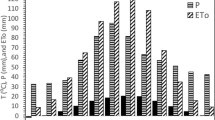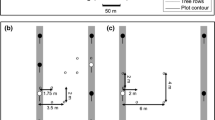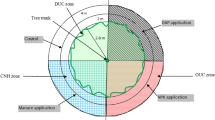Abstract
The success of agroforestry in semi-arid areas depends on efficient use of available water and effective strategies to limit tree/crop competition and maximise productivity. On hillsides, planting improved tree fallows on the degraded upper section of bench terraces is a recommended practice to improve soil fertility while cropping continues on the lower terrace to maintain food production. This study examined the influence of tree fallows on soil water content (θ w ) and evaporation (E s ). Alnus acuminata Kunth (alnus), Calliandra calothyrsus Meissner (calliandra), Sesbania sesban L. (sesbania), a mixture of all three species, or sole crops (beans (Phaseolus vulgaris L.) or maize (Zea mays L.)) were grown on the upper terrace. The same sole crops were grown on the lower terrace. Four management regimes (unpruned, root, shoot and root + shoot pruned) were applied to the tree rows adjacent to the cropping area. Neutron probe and microlysimeter approaches were used to determine θ w and E s when the trees were c. 3.5 years old. Sesbania and alnus increased θ w by 9–18 % in the cropping area on the lower terrace but calliandra reduced θ w by 3–15 %. After heavy rain, E s comprised 29–38 % of precipitation in the tree-based treatments and 53 % under sole crops. Absolute values declined as rainfall decreased, but E s as a proportion of rainfall increased to 39–45 % in the tree-based treatments and 62 % for sole crops. Root + shoot pruning of alnus and the tree mixture increased θ w in the cropping area but had no significant effect in the other tree-based treatments. The results suggest that sesbania and alnus can be planted on smallholdings without compromising water supply to adjacent crops, whereas calliandra decreased water availability despite reducing E s . These results provide a mechanistic understanding of reported effects on crop yield in the same site.




Similar content being viewed by others
References
Bayala J, Ouedraogo SJ, Teklehaimanot Z (2008) Rejuvenating trees in agroforestry systems for better fruit production using crown pruning. Agrofor Syst 72:187–194
Bell JP (1987) Neutron probe practice. Report 19, 3rd edn. Institute of Hydrology, Wallingford, 29 p
Chandrashekara UM (2007) Effects of pruning on radial growth and biomass increment of trees growing in homegardens of Kerala, India. Agrofor Syst 69:231–237
Cooper PJM, Leakey RRB, Rao MR, Reynolds L (1996) Agroforestry and the mitigation of land degradation in the humid and sub-humid tropics of Africa. Exp Agric 32:235–290
Daamen CC, Simmonds LP, Wallace JS, Laryea KK, Sivakumar MVK (1993) Use of microlysimeters to measure evaporation from sandy soils. Agric For Meteorol 65:159–173
Fischer G, Shah M, Tubiello FN, van Velthuizen H (2005) Socio-economic and climate change impacts on agriculture: an integrated assessment, 1990–2080. Phil Trans Roy Soc B 360:2067–2083
Gregory PJ, Ingram JSI (2000) Global change and food and forest production: future scientific challenges. Agric Ecosyst Environ 82:3–14
Hairiah K, van Noordwijk M, Santosa B, Syekhfani MS (1992) Biomass production and root distribution of eight trees and their potential for hedgerow intercropping on an ulitisol in Southern Sumatra. Agrivita 15:54–68
Hartemink AE, Buresh RJ, Jama B, Janssen BH (1996) Soil nitrate and water dynamics in Sesbania fallow, weed fallows and maize. Soil Sci Soc Am J 60:568–574
Hillel D (1998) Environmental soil physics. Academic Press, San Diego 771 p
Jackson NA, Wallace JS (1999) Soil evaporation: measurements in an agroforestry system in Kenya. Agric For Meteorol 94:203–215
Jackson NA, Wallace JS, Ong CK (2000) Tree pruning as a means of controlling water use in an agroforestry system in Kenya. For Ecol Manag 126:133–148
Jones M, Sinclair FL, Grime VL (1998) Effect of tree species and crown pruning on root length and soil water content in semi-arid agroforestry. Plant Soil 201:197–207
Kinama JM, Stigter CJ, Ong CK, Ng’ang’a JK, Gichuki FN (2005) Evaporation from soils below sparse crops in contour hedgerow agroforestry in semi-arid Kenya. Agric For Meteorol 130:149–162
Lin BB (2010) The role of agroforestry in reducing water loss through soil evaporation and crop transpiration in coffee agroecosystems. Agric For Meteorol 150:510–518
Lott JE, Khan AAH, Black CR, Ong CK (2003) Water use in a Grevillea robusta-maize overstorey agroforestry system in semi-arid Kenya. For Ecol Manag 180:45–59
Lott JE, Ong CK, Black CR (2009) Understorey microclimate and crop performance in a Grevillea robusta-based agroforestry system in semi-arid Kenya. Agric For Meteorol 149:1140–1151
Nyeko P, Stewart J, Franzel F, Barkland P (2004) Farmers’ experiences in the management and utilization of Calliandra calothrysus, a fodder shrub in Uganda. Agricultural Research and Extension Network (AgREN) Publication 140
Ong CK, Black CR, Marshall FM, Corlett JE (1996) Principles of resource capture and utilization of light and water. In: Ong CK, Huxley PA (eds) Tree-crop interactions in agroforestry systems: a physiological approach. CAB International, Wallingford, pp 73–158
Ong CK, Black CR, Muthuri CW (2006) Modifying forests and agroforestry for improved water productivity in the semi-arid tropics. CAB Rev Perspect Agric Vet Sci Nutr Nat Resour 65:1–19
Ong CK, Anyango S, Muthuri CW, Black CR (2007) Water use and water productivity of agroforestry systems in the semi-arid tropics. Ann Arid Zone 46:84–255
Otengi SBB, Stigter CJ, Ng’anga JK, Liniger H (2007) Soil moisture and its consequences in a six year old hedged agroforestry demonstration plot in semi-arid Kenya for two successive contrasting seasons. Afr J Agric Res 2:89–104
Radersma S, Ong CK (2004) Spatial distribution of root length density and soil water in linear agroforestry systems in sub-humid Kenya: implications for agroforestry models. For Ecol Manag 188:77–89
Raussen T, Siriri D, Ong C (1999) Trapping water, producing wood and improving yields through rotational woodlots on degraded parts of bench terraces in Uganda. East Afr Agric For J 65:85–93
Ritchie JT (1972) Model for predicting evaporation from a row crop with incomplete cover. Water Resour Res 8:1204–1213
Rosenzweig C, Strzepek KM, Major DC, Iglesias A, Yates DN, McCluskey A, Hillel D (2004) Water resources for agriculture in a changing climate: international case studies. Glob Environ Change 14:345–360
Sanchez PA, Shepherd KD, Soule MJ, Place FM, Buresh RJ (1997) Soil fertility replenishment in Africa: an investment in natural resource capital. In: Buresh RJ, Sanchez PA, Calhoun PG (eds) Replenishing soil fertility in Africa. Special Publication 51. Soil Science Society of America, Madison, pp 1–46
Schroth G (1999) A review of below-ground interactions in agroforestry, focusing on mechanisms and management options. Agrofor Syst 43:5–34
Siriri D, Bekunda MA (2004) Soil fertility management in Uganda: the potential of agroforestry. In: Proceedings of Second National Agroforestry Workshop, 10–14 Sep 2001, Mukono. ICRAF, Nairobi, pp 29–31
Siriri D, Raussen T (2003) Agronomic and economic potential of improved fallows on scoured terrace benches in the humid highlands of Southwestern Uganda. Agric Ecosyst Environ 95:359–369
Siriri D, Ong CK, Wilson J, Boffa JM, Black CR (2010) Tree species and pruning regime affect crop yield on bench terraces in SW Uganda. Agrofor Syst 78:65–77
Sun H, Tang Y, Xie J (2008) Contour hedgerow intercropping in the mountains of China: a review. Agrofor Syst 73:65–76
Swinkels RA, Franzel S, Shepherd KD, Ohlsson E, Ndufa JK (1997) The economics of short rotation improved fallows: evidence from areas of high population in western Kenya. Agric Syst 55:99–121
TIST (2008) Planting trees and improving agriculture for better lives. http://www.tist.org/
Villalobos FJ, Fereres E (1990) Evaporation measurements beneath corn, cotton and sunflower canopies. Agron J 82:1153–1159
Wajja-Musukwe T-N, Wilson J, Sprent JI, Ong CK, Deans JD, Okorio J (2008) Tree growth and management of Ugandan agroforestry systems: effects of root pruning on tree growth and crop yield. Tree Physiol 28:233–242
Wallace JS (1996) The water balance of mixed tree-crop systems. In: Ong CK, Huxley PA (eds) Tree-crop interactions: a physiological approach. CAB International, Wallingford, pp 189–233
Wallace JS, Gregory PJ (2002) Water resources and their use in food production systems. Aquat Sci 64:363–375
Wallace JS, Jackson NA, Ong CK (1999) Modelling soil evaporation in an agroforestry system in Kenya. Agric For Meteorol 94:189–202
Yamoah CF, Agboola AA, Mulongoy K (1986) Soil properties as affected by the use of leguminous shrubs for alley cropping in maize. Agric Ecosyst Environ 18:167–177
Acknowledgments
We thank the International Foundation for Science and USAID for funding and Posiano Nteziryayo for trial management and data collection.
Author information
Authors and Affiliations
Corresponding author
Rights and permissions
About this article
Cite this article
Siriri, D., Wilson, J., Coe, R. et al. Trees improve water storage and reduce soil evaporation in agroforestry systems on bench terraces in SW Uganda. Agroforest Syst 87, 45–58 (2013). https://doi.org/10.1007/s10457-012-9520-x
Received:
Accepted:
Published:
Issue Date:
DOI: https://doi.org/10.1007/s10457-012-9520-x




